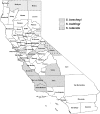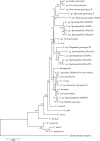Multiple unique Cryptosporidium isolates from three species of ground squirrels (Spermophilus beecheyi, S. beldingi, and S. lateralis) in California
- PMID: 20971867
- PMCID: PMC3008248
- DOI: 10.1128/AEM.00687-10
Multiple unique Cryptosporidium isolates from three species of ground squirrels (Spermophilus beecheyi, S. beldingi, and S. lateralis) in California
Abstract
Phylogenetic analyses of the 18S small-subunit (SSU) rRNA and Cryptosporidium oocyst wall protein (COWP) genes indicate that multiple unique Cryptosporidium isolates are shed by separate species of Spermophilus ground squirrels (S. beecheyi, S. beldingi, and S. lateralis) throughout California, despite some squirrel populations' being geographically isolated. The data support our assertion that Spermophilus squirrels shed novel Cryptosporidium species.
Figures



References
-
- Atwill, E. R., R. Phillips, and F. Rulofson. 2002. Environmental loading rates of the waterborne pathogenic protozoa Cryptosporidium parvum in certain domestic and wildlife species in California, p. 241-243. In R. M. Timm and R. H. Schmidt (ed.), Proceedings of the 20th Vertebrate Pest Conference, Reno, Nevada.
-
- Atwill, E. R., S. M. Camargo, R. Phillips, L. H. Alonso, K. W. Tate, W. A. Jensen, J. Bennet, S. Little, and T. P. Salmon. 2001. Quantitative shedding of two genotypes of Crypstosporidium parvum in California ground squirrels (Spermophilus beecheyi). Appl. Environ. Microbiol. 67:2840-2843. - PMC - PubMed
-
- Current, W. L. 1989. Cryptosporidium spp., p. 281-341. In P. D. Walzer and R. M. Genta (ed.), Parasitic infections in the compromised host. Marcel Dekker, New York, NY.
-
- da Silva, A. J., S. Cacciò, C. Williams, K. Y. Won, E. K. Nace, C. Whittier, N. J. Pieniazek, and M. L. Eberhard. 2003. Molecular and morphologic characterization of a Cryptosporidium genotype identified in lemurs. Vet. Parasitol. 111:297-307. - PubMed
Publication types
MeSH terms
Substances
Associated data
- Actions
- Actions
- Actions
- Actions
- Actions
- Actions
- Actions
- Actions
- Actions
LinkOut - more resources
Full Text Sources
Medical
Molecular Biology Databases

